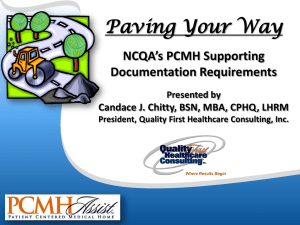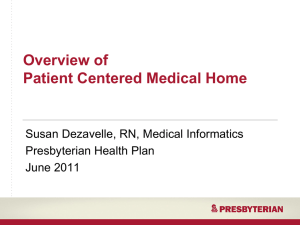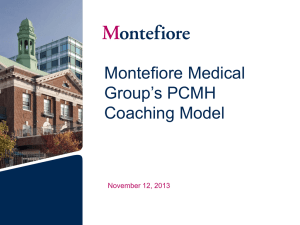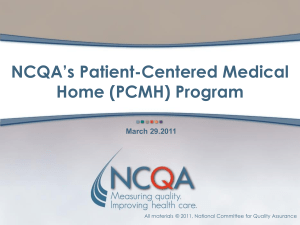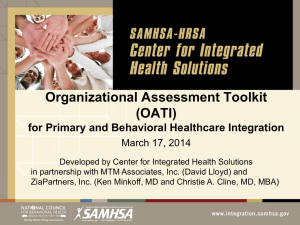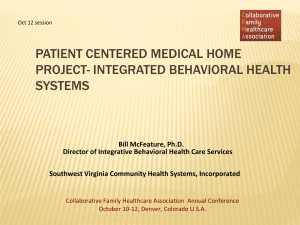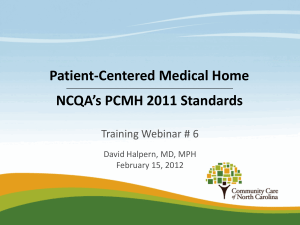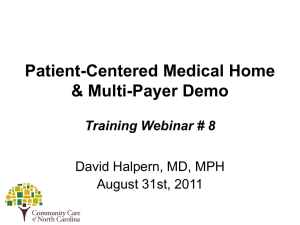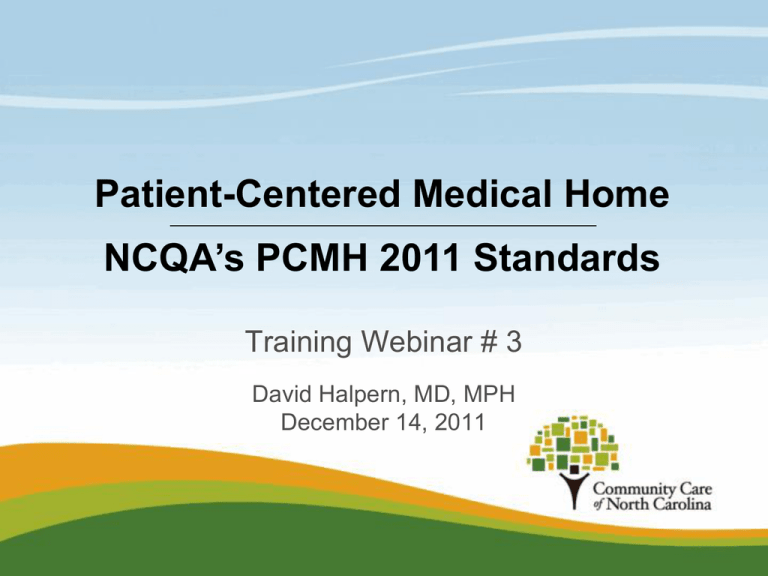
Patient-Centered Medical Home
NCQA’s PCMH 2011 Standards
Training Webinar # 3
David Halpern, MD, MPH
December 14, 2011
Legal Disclaimer
© Copyright 2011 North Carolina Community Care Networks,
Inc. All rights reserved. The content set forth herein is made
available on an “as is” basis without representation or warranty of
any kind and solely for use and distribution by primary care
physicians, without modification and only so long as the content of
this footer is reproduced on every copy thereof, in connection with
the internal activities of their respective not-for-profit organizations to
secure NCQA recognition as patient-centered medical homes. All
other uses of or modifications to the content set forth herein without
the prior express written approval of North Carolina Community
Care Networks, Inc. are strictly prohibited. Works copyrighted by
third parties and included herein are used with the permission of the
respective copyright owners in each case.
Acknowledgements
CCNC’s PCMH Resources
www.communitycarenc.org/emerging-initiatives/pcmh-central1/2011-pcmh-resources/
Let’s Review
• What is a “Must-Pass” Element?
• Element 1A (Must-Pass)
• Element 2D (Must-Pass)
• Element 5B (Must-Pass)
Today’s Agenda
• Standard 6 – Measure & Improve
Performance
– PCMH6A: Measure Performance
– PCMH6B: Measure Patient/Family Experience
– PCMH6C: Implement Continuous Quality
Improvement – MUST PASS
– PCMH6D: Demonstrate Continuous Quality
Improvement
– PCMH6E: Report Performance
– PCMH6F: Report Data Externally
PCMH 6A: Measure Performance
•
Practice measures or receives the
following data:
1. Three (3) preventive care measures
2. Three (3) chronic or acute care measures
3. Two (2) utilization measures affecting health
care costs
4. Vulnerable population data
PCMH 6A: Measure Performance
•
4 Points:
–
–
–
–
•
4 factors = 100%
2-3 factors = 75%
1 factors = 50%
0 factors = 0%
Data Sources:
– Reports showing performance
PCMH 6A: Example – Factor 2
PCMH 6A: Example – Factor 2
PCMH 6A: Example – Factor 2
This report shows
performance measures
for hypertension patients
at the practice level.
PCMH 6A: Example – Factor 2
This report shows
performance measures
for diabetes patients
at the provider level.
PCMH 6A: Explanation – Factor 4
• Vulnerable populations include “those who are
made vulnerable by their financial circumstances
or place of residence, health, age, personal
characteristics, functional or developmental
status, ability to communicate effectively, and
presence of chronic illness or disability” (AHRQ)
PCMH 6B: Measure Patient/Family
Experience
•
Practice obtains feedback on patient
experience with the practice and their care:
1. Practice conducts survey measuring
experience on at least three (3) of the
following: access, communication,
coordination, whole-person care
2. Practice uses PCMH CAHPS-CG survey tool
3. Practice obtains feedback from vulnerable
populations
4. Practice obtains feedback through qualitative
means
PCMH 6B: Measure Patient/Family
Experience
•
4 Points:
–
–
–
–
–
•
4 factors = 100%
3 factors = 75%
2 factors = 50%
1 factor = 25%
0 factors = 0%
Data Sources:
– Reports showing results of patient feedback
PCMH 6B: Example – Factor 1
PCMH 6B: Example – Factor 1
PCMH 6B: Example – Factor 2
• The Consumer Assessment of Healthcare
Providers and Systems (CAHPS) program is a
public-private initiative to develop standardized
surveys of patients' experiences.
• The PCMH CAHPS-CG survey was recently
released and is available at this website:
http://www.cahps.ahrq.gov/SurveysGuidance/CG/PCMH.aspx
PCMH 6B: Example – Factor 2
PCMH 6B: Example – Factor 2
PCMH 6B: Explanation – Factor 4
• Qualitative feedback methods may include
focus groups, individual interviews, patient
walkthroughs and/or suggestion boxes.
PCMH 6C: Implement Continuous
Quality Improvement (CQI)
•
Practice uses ongoing quality
improvement process:
1. Set goals and act to improve performance on
three (3) measures from Element 6A
2. Set goals and act to improve performance on
one (1) measure from Element 6B
3. Set goals and address at least one (1)
identified disparity in care for vulnerable
populations
4. Involve patients in QI teams or on the
practice’s advisory council
PCMH 6C: Implement Continuous
Quality Improvement (CQI)
•
•
Must Pass
4 Points:
–
–
–
–
•
3-4 factors = 100%
2 factors = 50%
(must-pass threshold)
1 factor = 25% (not sufficient for passing element)
0 factors = 0%
Data Sources:
–
–
Report or completed PCMH Quality Measurement
and Improvement worksheet
Process demonstrating how practice involves
patients/families in QI teams or advisory council
PCMH 6C: QI and the
“Model for Improvement”
• A description of this model and a brief
explanation of how to improve your
practice using a Plan-Do-Study-Act
(PDSA) cycle can be found at this website:
www.ihi.org/knowledge/Pages/HowtoImprove/
PCMH 6C: QI and the
“Model for Improvement”
ACT
• What needs to
be changed?
• Refine your
plan & start
again
STUDY
• Collect data
• Did it work?
• What did you
learn?
PLAN
• What do we
want to change?
• How can we
change it?
DO
• Test your
initiative
• Should be a
small-scale &
quick test
PCMH 6C: Example –
NCQA QI Workbook
PCMH 6C: Example –
NCQA QI Workbook
PCMH 6C: Where Do I Find the
NCQA QI Workbook?
• The Quality Measurement and Improvement Worksheet
is located in the PCMH Survey Tool (ISS).
• Once you have access to the Survey Tool:
– log into it and go to Element 6C
– click on the red supplemental worksheet button
– click on the red link
– save the workbook in your own computer to enter
data. Label it with a unique name but do not use a
“%” sign in the name of the document
– enter data in your Worksheet and then save and link
the completed Worksheet to the Survey Tool when
you are ready to submit
PCMH 6D: Demonstrate Continuous
Quality Improvement (CQI)
•
Practice demonstrates ongoing
monitoring of the effectiveness of its
improvement process:
1. Tracks results over time
2. Assesses effect of its actions
3. Achieves improved performance on one
measure
4. Achieves improved performance on a second
measure
PCMH 6D: Demonstrate Continuous
Quality Improvement (CQI)
•
3 Points:
–
–
–
–
–
•
4 factors = 100%
3 factors = 75%
2 factors = 50%
1 factor = 25%
0 factors = 0%
Data Sources:
–
Reports showing measures over time, NCQA
recognition results or completed Quality
Improvement Measurement and Improvement
Worksheet
PCMH 6D: Example – Factor 1 & 3
% of hypertension patients on aspirin
PCMH 6D: Example – Factor 1 & 3
% of hypertension patients with BP at goal
PCMH 6D: Example – Factor 1 & 3
% of diabetes patients with BP < 140/90 aspirin
HEDIS 90th percentile (75.5%)
our practice
PCMH 6D: Example – Factor 1, 3, & 4
Clinical Performance
Report
PCMH 6E: Report Performance
•
Practice shares data from Element A & B:
1. Within the practice, individual clinician results
2. Within the practice, practice results
3. With patients or public, individual clinician or
practice results
PCMH 6E: Report Performance
•
3 Points:
–
–
–
–
•
3 factors= 100%
2 factors= 75%
1 factors= 50%
0 factors = 0%
Data Sources:
– Reports (blinded) showing summary data and
how it provides results within the practice
– Example of patient/public report
PCMH 6E: Example – Factor 1
This report shows
performance measures
for diabetes patients
at the provider level.
When you measure this data,
you earn credit for PCMH 6A.
When you share this data,
You earn credit for PCMH 6E.
PCMH 6E: Example – Factor 2
This report shows
performance measures
for hypertension patients
at the practice level.
When you measure this data,
you earn credit for PCMH 6A.
When you share this data,
You earn credit for PCMH 6E.
PCMH 6F: Report Data Externally
• Practice electronically reports:
1. Ambulatory clinical quality measures to
CMS**
2. Data to immunization registries or systems**
3. Syndromic surveillance data to public health
agencies**
**Meaningful Use Requirement
PCMH 6F: Report Data Externally
• 2 Points:
– 3 factors= 100%
– 2 factors= 75%
– 1 factor= 50%
– 0 factors = 0%
• Data Sources:
– Reports demonstrating data submission
PCMH 6F: Example – Factor 1
Next Steps (Homework)
• Review the requirements for Standard 6
– What does the practice already do?
– What does the practice need to
adopt/implement?
– Are there elements the practice clearly does
not have in place and does not plan to have in
place in time for submission?
Next Steps (Homework)
• Organize Your Documents
– Create a place on your computer (server or
hard-drive) for all of your documentation
– You should have a folder for each standard
– A checklist can help you determine what you
already have created/saved and what you
need to prepare from scratch
Next Steps (Homework)
• Go to NCQA’s website and take
advantage of the various (free) training
presentations they have available:
– 2011 Standards
– Using the ISS Interactive Survey System
– Submitting As a Multi-Site Practice
• http://www.ncqa.org/tabid/109/Default.aspx
Community Care PCMH Team
• David Halpern, MD, MPH
Community Care of North Carolina (CCNC)
• R.W. “Chip” Watkins, MD, MPH, FAAFP
Community Care of North Carolina (CCNC)
• Brent Hazelett, MPA
North Carolina Academy of Family Physicians
(NCAFP)
• Elizabeth Walker Kasper, MSPH
North Carolina Healthcare Quality Alliance (NCHQA)
NCQA Contact Information
Contact NCQA Customer Support to:
• Order FREE Copy of requirements
• Order FREE Application Information
• Purchase ISS Tool
• 1-888-275-7585
Visit NCQA Web Site to:
• View Frequently Asked Questions
• View Recognition Programs Training Schedule
• www.ncqa.org/medicalhome.aspx
Send Questions to: ppc-pcmh@ncqa.org
Questions?
Feel free to contact me:
David Halpern, MD, MPH
(215) 498-4648
dhalpern@n3cn.org

